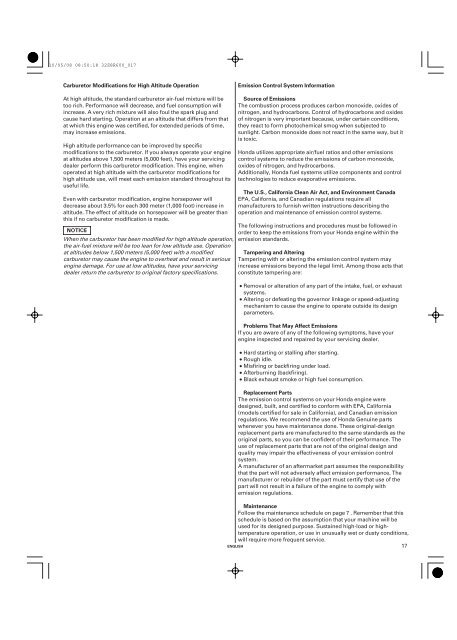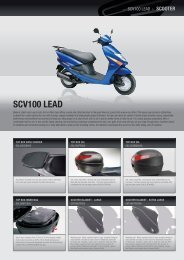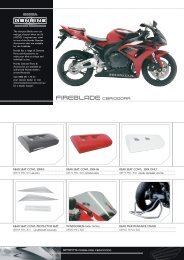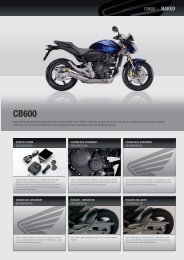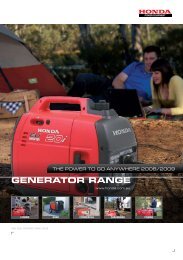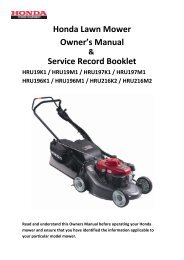GX240 · GX270 · GX340 · GX390 - Honda Motorcycles
GX240 · GX270 · GX340 · GX390 - Honda Motorcycles
GX240 · GX270 · GX340 · GX390 - Honda Motorcycles
Create successful ePaper yourself
Turn your PDF publications into a flip-book with our unique Google optimized e-Paper software.
10/05/08 08:50:18 32Z8R600_017<br />
Carburetor Modifications for High Altitude Operation<br />
At high altitude, the standard carburetor air-fuel mixture will be<br />
too rich. Performance will decrease, and fuel consumption will<br />
increase. A very rich mixture will also foul the spark plug and<br />
cause hard starting. Operation at an altitude that differs from that<br />
at which this engine was certified, for extended periods of time,<br />
may increase emissions.<br />
High altitude performance can be improved by specific<br />
modifications to the carburetor. If you always operate your engine<br />
at altitudes above 1,500 meters (5,000 feet), have your servicing<br />
dealer perform this carburetor modification. This engine, when<br />
operated at high altitude with the carburetor modifications for<br />
high altitude use, will meet each emission standard throughout its<br />
useful life.<br />
Even with carburetor modification, engine horsepower will<br />
decrease about 3.5% for each 300 meter (1,000 foot) increase in<br />
altitude. The effect of altitude on horsepower will be greater than<br />
this if no carburetor modification is made.<br />
When the carburetor has been modified for high altitude operation,<br />
the air-fuel mixture will be too lean for low altitude use. Operation<br />
at altitudes below 1,500 meters (5,000 feet) with a modified<br />
carburetor may cause the engine to overheat and result in serious<br />
engine damage. For use at low altitudes, have your servicing<br />
dealer return the carburetor to original factory specifications.<br />
ENGLISH<br />
Emission Control System Information<br />
Source of Emissions<br />
The combustion process produces carbon monoxide, oxides of<br />
nitrogen, and hydrocarbons. Control of hydrocarbons and oxides<br />
of nitrogen is very important because, under certain conditions,<br />
they react to form photochemical smog when subjected to<br />
sunlight. Carbon monoxide does not react in the same way, but it<br />
is toxic.<br />
<strong>Honda</strong> utilizes appropriate air/fuel ratios and other emissions<br />
control systems to reduce the emissions of carbon monoxide,<br />
oxides of nitrogen, and hydrocarbons.<br />
Additionally, <strong>Honda</strong> fuel systems utilize components and control<br />
technologies to reduce evaporative emissions.<br />
The U.S., California Clean Air Act, and Environment Canada<br />
EPA, California, and Canadian regulations require all<br />
manufacturers to furnish written instructions describing the<br />
operation and maintenance of emission control systems.<br />
The following instructions and procedures must be followed in<br />
order to keep the emissions from your <strong>Honda</strong> engine within the<br />
emission standards.<br />
Tampering and Altering<br />
Tampering with or altering the emission control system may<br />
increase emissions beyond the legal limit. Among those acts that<br />
constitute tampering are:<br />
Removal or alteration of any part of the intake, fuel, or exhaust<br />
systems.<br />
Altering or defeating the governor linkage or speed-adjusting<br />
mechanism to cause the engine to operate outside its design<br />
parameters.<br />
Problems That May Affect Emissions<br />
If you are aware of any of the following symptoms, have your<br />
engine inspected and repaired by your servicing dealer.<br />
Hard starting or stalling after starting.<br />
Rough idle.<br />
Misfiring or backfiring under load.<br />
Afterburning (backfiring).<br />
Black exhaust smoke or high fuel consumption.<br />
Replacement Parts<br />
The emission control systems on your <strong>Honda</strong> engine were<br />
designed, built, and certified to conform with EPA, California<br />
(models certified for sale in California), and Canadian emission<br />
regulations. We recommend the use of <strong>Honda</strong> Genuine parts<br />
whenever you have maintenance done. These original-design<br />
replacement parts are manufactured to the same standards as the<br />
original parts, so you can be confident of their performance. The<br />
use of replacement parts that are not of the original design and<br />
quality may impair the effectiveness of your emission control<br />
system.<br />
A manufacturer of an aftermarket part assumes the responsibility<br />
that the part will not adversely affect emission performance. The<br />
manufacturer or rebuilder of the part must certify that use of the<br />
part will not result in a failure of the engine to comply with<br />
emission regulations.<br />
Maintenance<br />
Follow the maintenance schedule on page 7 . Remember that this<br />
schedule is based on the assumption that your machine will be<br />
used for its designed purpose. Sustained high-load or hightemperature<br />
operation, or use in unusually wet or dusty conditions,<br />
will require more frequent service.<br />
17


